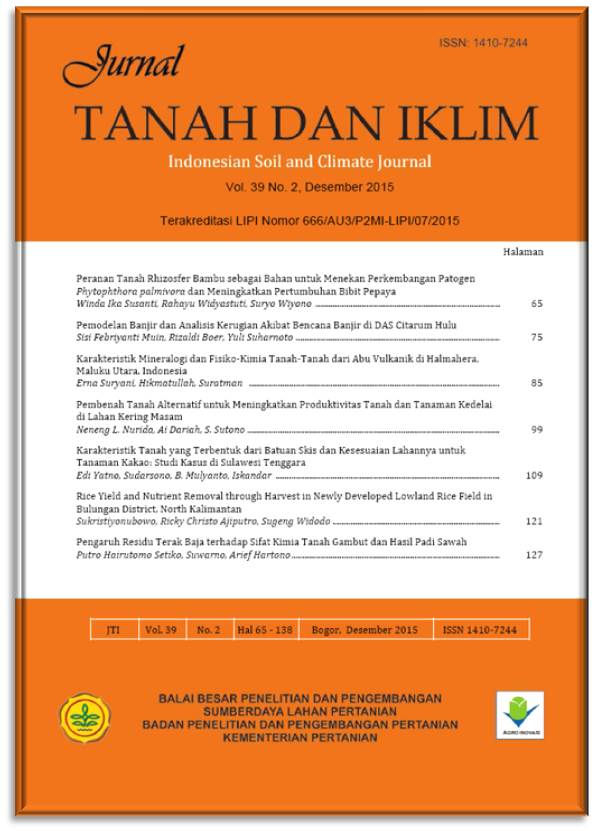Karakteristik Mineralogi dan Fisiko-Kimia Tanah-Tanah dari Abu Vulkanik di Halmahera, Maluku Utara, Indonesia
Abstract
Abstrak. Informasi tentang sifat-sifat tanah dari abu vulkanik di Pulau Halmahera bagian utara Maluku, masih sedikit. Untuk itu sifat morfologi, fisiko-kimia dan mineralogi dari enam profil tanah telah diteliti untuk menentukan jika tanah memenuhi sifat tanah andik. Penelitian dilaksanakan pada tahun 2013-2014. Komposisi mineral pasir ditentukan dengan metode line counting, dan mineral liat dengan X-Ray Difractometer melalui penjenuhan Mg2+. Analisis sifat fisiko-kimia tanah meliputi: tekstur (metode pipet), pH tanah diukur di dalam H2O dan 1 M KCl (rasio tanah dan larutan 1:5); C organik (Walkley and Black); N total (Kjeldahl); P dan K total (ekstraksi HCl 25%), P tersedia (ekstraksi Olsen dan Bray I); Ca, Mg, K, Na dapat tukar dan KTK (ekstraksi NH4OAc pada pH 7,0), kejenuhan basa (persentase jumlah basa-basa); total hara mikro Fe, Mn, Cu, Zn, B, Ni, Cr, dan Mo (ekstrasi HNO3 + HClO4). Hasil penelitian menunjukkan tanah berwarna coklat gelap sampai hitam pada lapisan atas, konsistensi gembur, tekstur sedang dengan kandungan pasir >40%. Mineral pasir didominasi oleh gelas vulkanik, labradorit, bitownit, augit dan hiperstin, sedikit andesin dan olivin yang menunjukkan abu vulkanik bersifat andesit-basalt. Fraksi liat didominasi oleh alofan dan haloisit. Tanah memiliki C organik tinggi (>3,0%) pada lapisan atas dan menurun dengan kedalaman. Reaksi tanah agak masam (pH H2O 6,0-6,5), KTK tanah rendah sampai tinggi (4-29 cmolc kg-1) dan kejenuhan basa tinggi (>35%). Retensi P tinggi (31-78%), demikian juga dengan pH NaF (9,23-10,92). Alo+0,5Feo bervariasi dari 0,32-5,56% dan indeks sifat tanah andik: [%(Alo+0,5Feo) x 15,625 + (% gelas vulkanik)] >36,25. Retensi air pada 1.500 kPa <15%. Lima profil memenuhi sifat tanah andik diklasifikasi sebagai Andisols, dan profil lainnya sebagai Inceptisols. Kelas kesesuaian lahan termasuk sangat sesuai (S1) sampai sesuai marginal (S3) untuk tanaman pangan lahan kering, dengan faktor pembatas KTK rendah di sebagian profil, disamping bahaya erosi pada daerah berlereng >3%.
ÂÂÂÂ
Abstract. Information of soil properties formed on volcanic ashes in the northern Halmahera Island, Maluku, is rather scanty. We studied the morphological, physicho-chemical characteristics and mineralogical of six soil profiles to determine whether these soils meet the andic soil properties. This study was conducted in 2013-2014. Sand mineral composition was determined using line counting, and clay mineral by X-Ray Difractometer with Mg2+saturation. Analysis of physicho-chemical properties are: texture (pipette method), soil pH was measured in H2O and 1 M KCl at a 1:5 soil/solution ratio; organic C (Walkley and Black); total-N (Kjeldahl), total-P and total K (HCl 25% extraction); available-P (Olsen or Bray I extraction), and exchangeable bases and CEC (NH4OAc pH 7.0); base saturation (sum of bases percentage); total-micronutrients Fe, Mn, Cu, Zn, B, Ni, Cr, and Mo (HNO3 + HClO4 extraction). The topsoil was dark brown to black in color, medium texture (sand content > 40%) and friable in consistency. The composition of sand fraction was dominated by volcanic glasses, labradorite, bitownite, augite and hypersthene, with some andesine and olivine, indicating that the volcanic ash has andesit-basaltic properties. The clay fraction dominated by allophane and halloysite. These soils had a high organic C content (> 3.0%) in the topsoil which decreased with depth, slightly acidic in reaction (pH H2O 6.0-6.5), low to high CEC (4-29 cmolc kg-1) and high base saturation (>35%). The P retention was high (31-78%) and so was pH NaF (9.23-10.92). Alo+0.5Feo varied from 0.32-5.56%, and [%(Alo+0.5Feo) x 15.625 + (% volcanic glasses)] was >36.25. Water retention at 1.500 kPa was <15%. Five profiles met the andic soil properties; thus, classified as Andisols, and the rests were classified as Inceptisols. Suitability evaluation showed that the land was very suitable to marginally suitable for upland food crops, whith the low CEC and high erosian hazard on land with slopes >3% as the limiting factors.


